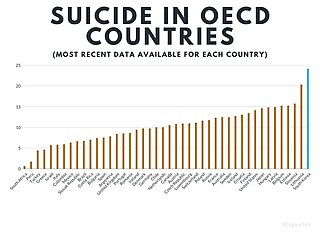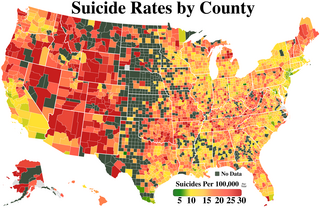Suicide is the second leading cause of death for people in the United States from the ages of 9 to 56.
There are more than 700,000 estimated suicide deaths every year. Suicide affects every demographic, yet there are some populations that are more impacted than others. For example, among 15–29 year olds, suicide is much more prominent; this being the fourth leading cause of death within this age group.
In Japan, suicide is considered a major social issue. In 2017, the country had the seventh highest suicide rate in the OECD, at 14.9 per 100,000 persons, and in 2019 the country had the second highest suicide rate among the G7 developed nations.

Suicide is the act of intentionally causing one's own death. Mental disorders, physical disorders, and substance abuse are risk factors. Some suicides are impulsive acts due to stress, relationship problems, or harassment and bullying. Those who have previously attempted suicide are at a higher risk for future attempts. Effective suicide prevention efforts include limiting access to methods of suicide such as firearms, drugs, and poisons; treating mental disorders and substance abuse; careful media reporting about suicide; improving economic conditions; and dialectical behaviour therapy (DBT). Although crisis hotlines are common resources, their effectiveness has not been well studied.
An occupational fatality is a death that occurs while a person is at work or performing work related tasks. Occupational fatalities are also commonly called "occupational deaths" or "work-related deaths/fatalities" and can occur in any industry or occupation.

Suicide in South Korea occurs at the 12th highest rate in the world. South Korea has the highest recorded suicide rate in the OECD. In South Korea, it is estimated to affect 0.02 percent of the population by the WHO. In 2012, suicide was the fourth-highest cause of death. The suicide rate has consistently declined between 2012 and 2019, the year when the latest data are available.

Gender differences in suicide rates have been shown to be significant. There are different rates of suicides and suicidal behavior between males and females. While females more often have suicidal thoughts, males die by suicide more frequently. This discrepancy is also known as the gender paradox in suicide.
World Suicide Prevention Day (WSPD) is an awareness day always observed on 10 September every year, in order to provide worldwide commitment and action to prevent suicides, with various activities around the world since 2003. The International Association for Suicide Prevention (IASP) collaborates with the World Health Organization (WHO) and the World Federation for Mental Health (WFMH) to host World Suicide Prevention Day. In 2011 an estimated 40 countries held awareness events to mark the occasion. According to WHO's Mental Health Atlas released in 2014, no low-income country reported having a national suicide prevention strategy, while less than 10% of lower-middle income countries, and almost a third of upper-middle and high-income countries had.

Suicide is a major national public health issue in the United States. The country has one of the highest suicide rates among wealthy nations. In 2020, there were 45,799 recorded suicides, up from 42,773 in 2014, according to the CDC's National Center for Health Statistics (NCHS). On average, adjusted for age, the annual U.S. suicide rate increased 30% between 2000 and 2020, from 10.4 to 13.5 suicides per 100,000 people. In 2018, 14.2 people per 100,000 died by suicide, the highest rate recorded in more than 30 years. Due to the stigma surrounding suicide, it is suspected that suicide is generally underreported. In April 2016, the CDC released data showing that the suicide rate in the United States had hit a 30-year high, and later in June 2018, released further data showing that the rate has continued to increase and has increased in every U.S. state except Nevada since 1999. From 2000 to 2020, more than 800,000 people died by suicide in the United States, with males representing 78.7% of all suicides that happened between 2000 and 2020. In 2022, a record high 49,500 people died by suicide, while the suicide rate in 2022 reached its highest level since 1941 at 14.3 per 100,000 persons. Surging death rates from suicide, drug overdoses and alcoholism, what researchers refer to as "deaths of despair", are largely responsible for a consecutive three year decline of life expectancy in the U.S. This constitutes the first three-year drop in life expectancy in the U.S. since the years 1915–1918.
China's suicide rates were one of the highest in the world in the 1990s. However, by 2011, China had one of the lowest suicide rates in the world. According to the World Health Organization, the suicide rate in China was 9.7 per 100,000 as of 2016. As a comparison, the suicide rate in the U.S. in 2016 was 15.3. Generally speaking, China seems to have a lower suicide rate than neighboring Korea, Russia and Japan, and it is more common among women than men and more common in the Yangtze Basin than elsewhere.

Suicide rates in India have been rising over the past five decades. Suicides during 2021 increased by 7.2% in comparison to 2020 with India reporting highest number of suicides in the world. India's contribution to global suicide deaths increased from 25.3% in 1990 to 36.6% in 2016 among women, and from 18.7% to 24.3% among men. In 2016, suicide was the most common cause of death in both the age groups of 15–29 years and 15–39 years. Between 1987 and 2007, the suicide rate increased from 7.9 to 10.3 per 100,000, with higher suicide rates in southern and eastern states of India. Daily wage earners registered 42,004 deaths by suicide in 2021, the biggest group in the suicide data.
According to the Australian Bureau of Statistics, the age standardised death rate for suicide in Australia, for the year 2019, was 13.1 deaths per 100,000 people; preliminary estimates for years 2020 and 2021 are respectively 12.1 and 12.0. In 2020, 3,139 deaths were due to suicide ; in 2021, 3,144 deaths were due to suicide.

Switzerland had a standardised suicide rate of 10.7 per 100,000 as of 2015. The actual (non-standardised) rate was 12.5 in 2014.

According to the latest available data, Statistics Canada estimates 4,157 suicides took place in Canada in 2017, making it the 9th leading cause of death, between Alzheimer's disease (8th) and cirrhosis and other liver diseases (10th). In 2009, there were an estimated 3,890 suicide deaths.
Suicide in Sri Lanka is a common cause of unnatural death and a long term social issue. In the past, Sri Lanka had one of the highest suicide rates in the world. For several years before 2000, the suicide rate remained at 35 to 47 per 100,000 persons. The introduction in pesticide control regulations coincided with a reduction in suicide rates in Sri Lanka. Sri Lanka Federation for Suicide Prevention is an independent organisation working on suicide prevention in Sri Lanka.
Suicide in Kazakhstan is a very common cause of unnatural death in the country and a long term social issue. According to the 2011 report of World Health Organization, of all the people reported dead due to suicide worldwide every year, 3.23% belong to Kazakhstan. Suicide of teenaged and young aged people is a big issue in the country. In the age group of 15-49 year olds, suicide makes up for 12.2% of all deaths in Kazakhstan.

Suicide in Greenland, an autonomous country within the Kingdom of Denmark, is a significant national social issue. Greenland has the highest suicide rate in the world: reports between 1985 and 2012 showed that an average of 83 people in 100,000 died by suicide yearly.

United States military veteran suicide is an ongoing phenomenon regarding the high rate of suicide among U.S. military veterans in comparison to the general civilian public. A focus on preventing veteran suicide began in 1958 with the opening of the first suicide prevention center in the United States. During the mid-1990s, a paradigm shift in addressing veteran suicide occurred with the development of a national strategy which included several Congressional Resolutions. More advancements were made in 2007, when the Joshua Omvig Veterans Suicide Prevention Act created a comprehensive program including outreach at each Veterans Affairs Office (VA) and the implementation of a 24-hour crisis hotline. PTSD, depression, and combat-related guilt in veterans are often related to suicide as it can be difficult for veterans to transition to civilian life.
Suicide in Belarus is a common cause of unnatural death in the country, which in 2016 ranked in the top 10 worldwide by its total suicide per 100,000 people. Prior to the 1998 Russian financial crisis, suicide numbers had been decreasing year-upon-year, yet saw a noticeable increase in the years following.









